30th September
And so another Shetland bound adventure begins. I headed over mid-morning and decided to
divert into Fairlop Waters to have a look for the Blue-winged Teal that had
been around for a couple of days. I am
not overly precious about my lists but this species was missing from both my
Essex and LNHS tallies so there was an edge of keenness as I ambled around the
lake for a look at this smart little dabbler.
It was easily picked out on the edge of the main island where it was
loosely surface feeding with a couple of Mallard. It was immaculate and was certainly un-ringed
and did not have a wing feather out of place.
The forewings were exceptionally blue and face on there was a ghosting
of a facial crescent not visible when side on and these combined with the already
quite yellowy legs perhaps suggest that this presumed juvenile may be a male?
 |
| Blue-winged Teal |
.jpg) |
| Blue-winged Teal - one from Russ Sherriff as his are far better! |
I spent a pleasant visit there in the company of six good
friends whom I had not seen since leaving Rainham and picked up a couple of
singing Cetti’s Warblers, calling Chiffchaffs, a Willow Warbler and Grey
Wagtails in the margins along with two newish broods of Egyptian Geese.
I battled my way back out of town and headed up the A12
passing a Red Kite leisurely wafting alongside the road at Witham before cutting
across to Abberton.
I spent a good couple of hours flitting between the causeways
and Billets and Wigborough screens (bumping into, as usual Daryl R in the
process) and trying to predict when it may rain. In the process I saw 17 Great White Egrets, a
pair of Red-crested Pochards, Goldeneye, a dinky Black-necked Grebe and a very
respectable selection of waders.
 |
| Great White Egret |
 |
| Red-crested Pochard |
 |
| Red-crested Pochards |
 |
| Shoveler |
For an inland site a tally of 24 Dunlin, 13 Curlew
Sandpiper, Little Stint, 17 Ringed Plover, Grey Plover, 30 Golden Plover, 200
Lapwing, 26 Ruff, 140 Black-tailed Godwit, six Greenshank, 3 Spotted Redshank,
Snipe and Jack Snipe is pretty impressive.
Throw in a sprinkling of fast moving Swallows and Martins, all three
Wagtails, platoons of duck, a hiding Kingfisher and at least six Buzzard, four
Marsh Harriers, two imm female Peregrines, adult Hobby and Kestrel and it was
time well spent before a timely call from Bradders, mere minutes before the
rain started had me retreating to a cosy sofa with a cup of tea in Colchester
in preparation for the journey northwards the following morning.
 |
| Peregrine |
1st October:
We made an early start and worked our way west to meet Peter M
in Cambourne before the slog onwards. There
was quite literally nothing special to go for on the entire east coast so we
set Agnetha (Mr B’s Volvo) on a course to Lindisfarne and pressed go. The miles slid by with occasional Red Kite
and Buzzard action before we crossed the causeway onto the island. It was a Saturday, the sky was blue and the
strong westerly had not deterred the crowds but I had never been beyond The Snook
before so it was worth the effort. The
House Sparrows moved around the tea gardens mob handed but the chances of us
finding a Yellow-browed Warbler in the thrashing Sycamores was remote and we
had to be content with fine views of the Priory and Castle and countless waders
out on the flats between the island and mainland where flocks of Pale-bellied
Brent Geese were already back for the winter.
 |
| House Sparrows - proper little bruisers |
 |
| Pale-bellied Brent Geese |
The low moaning of Grey Seals could be heard and a long low dark
island was in fact a mass of hundreds of these mournful singers. News of a possible Buff-bellied Pipit on the
island set us on a looping course out of the village and off into the dune system
via a series of tracks. Song Thrush,
Tree Sparrows and a Brambling were seen on the walk out and four Roe Deer
loafed in a field while drifts of Starlings swirled around over the fields
with a few Lapwing and Golden Plover.
 |
| Grey Seals |
 |
| Starlings |
 |
| Roe Deer |
A small gathering of birders was not for any errant Pipits (nobody was particularly enthused about it!) but for a solitary Willow clump in which
we saw Goldcrest, Yellow-browed Warbler, Pied Flycatcher and Redstart in quick
succession. Bar a Robin we did not see
one more bush bound passerine on the entire walk.
 |
| Golden Plover |
 |
| Bombus pascuorum |
 |
| Calliphora |
 |
Calliphora vicina I reckon
|
 |
Calliphora
|
 |
Fox Moth cat
|
 |
| Grass
of Parnassus - Parnassia palustris |
The bays were devoid of visitors but good for
checking Rock and Meadow Pipits and scuttling White Wagtails while the rocky
foreshore had Turnstones, Ringed Plovers, Oystercatchers, Bar-tailed Godwits
and Redshanks. Gannets milled offshore with flocks of bobbing Guillemots and
Razorbills and a Bonxie snuck past.
 |
| Oystercatcher |
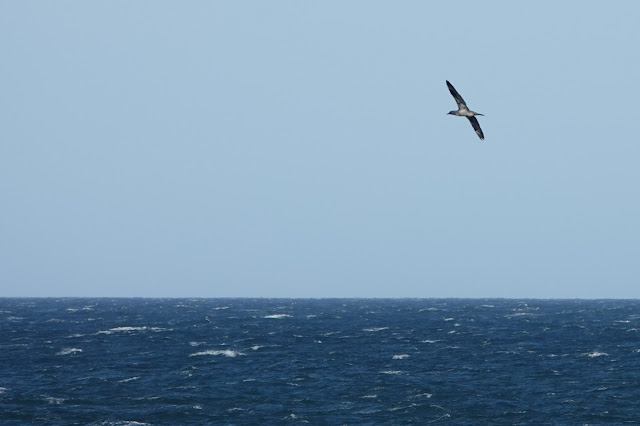 |
| Gannet - good to see several juveniles |
 |
| low light Limpet |
After enjoying the scenic coast views we headed back to the car park
where a sad looking Guillemot was just sitting forlornly in a field and gangs
of mainly first winter Starlings energetically attempted to drain the puddles
with their frenzied flapping.
 |
| Rural Guillemot |
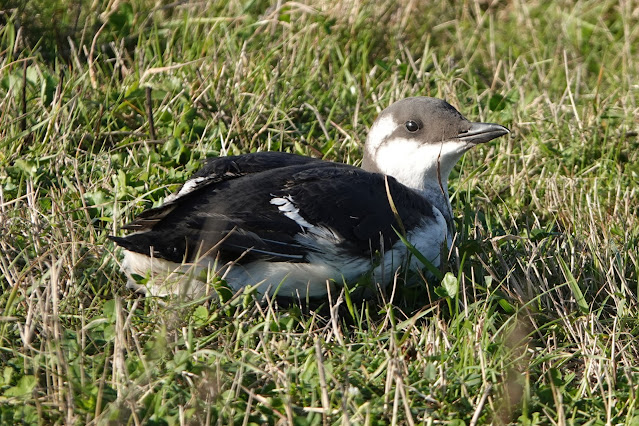 |
| Guillemot |
 |
| Mass Flapping in a Puddle |
We moved up the coast a little way to visit Cocklawburn
where a Black Scoter was once again reported about a week ago but not since.
The scopes were soon in action on the main flock of over 400 Commons and very
quickly we picked up on this distinctive drake with his golden egg perched up
on top of his bill. This was my first since
the Newgale drake way back on 19th January 1991. We got quite adept at picking him up as he
fed en masse with his European cousins and he seemed a little bulkier and with
a more thickset neck. A single
Long-tailed Duck was also with the flock.





There were other birds too including Red-throated Divers, Eiders, Auks, Kittiwakes and a juvenile Arctic Tern while two Ravens barrelled down the
cliff line. With the day wearing on and
pleased with our re-discovery we moved inland to the YHA in Wooler with its fine
backdrop of the Cheviots as the sun went down.
Dinner at the Black Bull in Lowick was once again fabulous with local
Roe Deer pie and a pint of cider being a fine way to end the day.
The Milky Way, Jupiter and some large bats greeted us on our
return to the hostel.
2nd October:
Up and out early and up to Berwick for breakfast before a
stop at Musselburgh for some quality time with the seaduck and waders in perfect
mid-morning light on a dropping tide.
The male King Eider was our quarry and it took until almost the final
scan for David to find him way out off towards Edinburgh but in such good conditions
we could see the orange bill and making of a lavender head but it was the white
thigh patches that stood out the most. There were plenty of Common Eiders along
with six Goosander (on the Esk) and at least 50 Mergansers. My favourites were
the Velvet Scoter with at least 21 seen of which only three were females. Watching the almost glossy males flying about
with wing patches flashing above and below, yellow bills and white eye commas
gleaming and vivid pinky red legs splayed for splash landings was a true joy.
 |
| The Esk just a few 100m up stream in town with... |
 |
| Goosander |
 |
| Eiders |
 |
| Velvet Scoter |
 |
| Velvet Scoter |
As the tide dropped waders started to move from their
easterly roosts along the sea front to the exposing mud beyond the river mouth
and shimmered past us at close range.
Most were Oystercatchers, Curlew and Redshank but with the odd Knot,
Dunlin and Ringed and Grey Plover and pulses of tight flocks of determined
Bar-tailed Godwits. A single Whimbrel
circled and was probably wondering where its friends had gone.
 |
| Redshank |
 |
| Redshank |
 |
| Redshank |
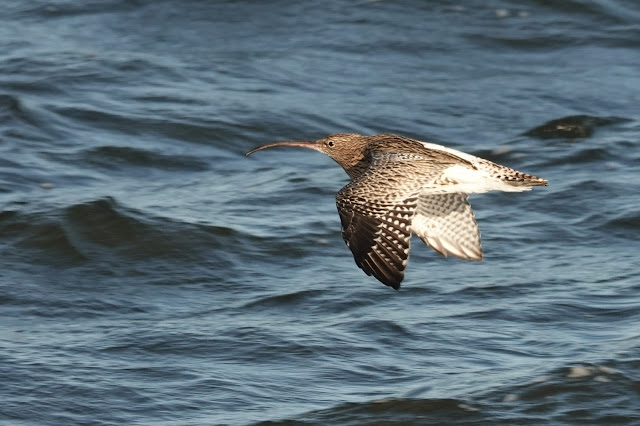 |
| Curlew |
 |
| Curlew |
 |
| Curlew |
 |
| Curlew |
 |
| Curlew and Oystercatcher |
 |
| Curlew |
 |
| Bar-tailed Godwits |
 |
| Bar-tailed Godwits |
 |
| Bar-tailed Godwits |
 |
| Bar-tailed Godwits |
 |
| Oystercatchers |
 |
| Oystercatchers |
 |
| Oystercatchers |
 |
| Oystercatcher |
Sandwich Terns patrolled back and forth with some immaculate
juvenile Common Gulls, two Arctic Terns and a few paddling auks and Shags.
 |
| Guillemot |
 |
| Greylags |
Skylarks, Linnets, Goldfinches, Chaffinches,
Grey Wagtails and Meadow Pipits were seen coming across the Firth of Forth and on
the green there were eight White Wagtails and seven juvenile Swallows that did
not look to be too long out of the nest and with many miles left yet to travel.
Let’s hope they make it there and back.
 |
| Swallows |
On again with a final stop around Montrose Basin (where the
tide was out) where a Red-throated Diver, Eider, Guillemots and Goosander were
seen at Ferryden along with a very healthy population of Fishermans Sparrows.
 |
| I loved the washing lines strung out over the beach |
 |
| Sparrows in the Lobsterpots |
 |
| Beach bathing |
 |
| Goosander |
 |
| Goosander |
 |
| Eider |
 |
| Eider |
 |
| Eider |
A walk up the lane at the Mains of Usan revealed a magnificent garden and vegetated
lake but the wind was frustrating and we had to be content with a Blackcap, couple
of Chiffchaffs and an obliging Treecreeper.
There was the odd mature Elm still standing and a couple of Common Darters
along with Nettle Tap moth, Red Admiral and Green-veined White. The tell tale winking of Pinkfeet drew us to
a field with several hundred hunkered down in it but very soon the word went
out and they gradually took off in small groups and moved a little further to
the south.
 |
| There were 300 Linnet in this field |
 |
| Common Darter |
 |
| Common Darter |
 |
| Treecreeper |
 |
| Seven Spot Ladybird |
 |
| Elm |
Our Aberdeen ferry was an early one, 5pm, as it would be
stopping at Kirkwall in Orkney on the way up and so with just an hour left we
completed the last leg of the journey and drove straight onto the near empty
Hjatland where unusually we still had some daylight to play with and spent
about an hour up on the top deck watching little flocks of Guillemots,
Razorbills and even a few Puffins bob by while the sun set before the cold sent
us in for a curry and a good night’s sleep.

.jpg)







































































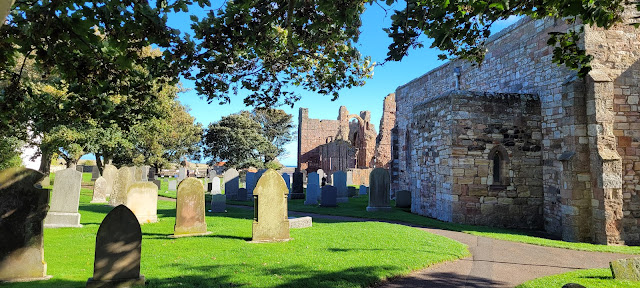




































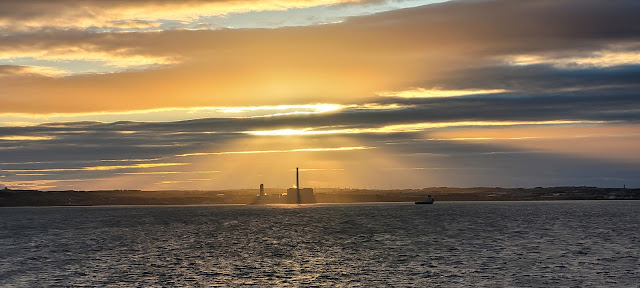
No comments:
Post a Comment